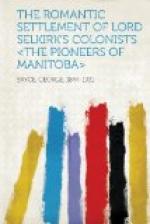Some thirty years before the arrival of the Colonists, the Montreal traders found it useful to form a Company. This was called the North-West Fur Company of Montreal. Having taken large amounts out of the fur trade, they became the leaders among the merchants of Montreal. The Company had an energy and ability that made them about the beginning of the nineteenth century the most influential force in Canadian life. At Fort William and Lachine their convivial meetings did something to make them forget the perils of the rapids and whirlpools of the rivers, and the bitterness of the piercing winds of the northwestern stretches. Familiarly they were known as the “Nor’-Westers.” Shortly before the beginning of the century mentioned, a split took place among the “Nor’-Westers,” and as the bales of merchandise of the old Company had upon them the initials “N.W.,” the new Company, as it was called, marked their packages “XY,” these being the following letters of the alphabet.
Besides these mentioned there were a number of independent merchants, or free traders. At one time there were at the junction of the Souris and Assiniboine Rivers, five establishments, two of them being those of free traders or independents. Among all these Companies the commander of a Fort was called, “The Bourgeois” to suit the French tongue of the men. He was naturally a man of no small importance.
“The dusky riders of the plains.”
But the conditions, in which both the traders and the voyageurs lived, brought a disturbing shadow over the wide plains of the North-West. Now under British rule, the Fur trade from Montreal became a settled industry. From Curry’s time (1766) they began to erect posts or depots at important points to carry on their trade. Around these posts the voyageurs built a few cabins and this new centre of trade afforded a spot for the encampment near by of the Indian teepees made of tanned skins. The meeting of the savage and the civilized is ever a contact of peril. Among the traders or officers of the Fur trade a custom grew up—not sanctioned by the decalogue—but somewhat like the German Morganatic marriage. It was called “Marriage of the Country.” By this in many cases the trader married the Indian wife; she bore children to him, and afterwards when he retired from the country,




